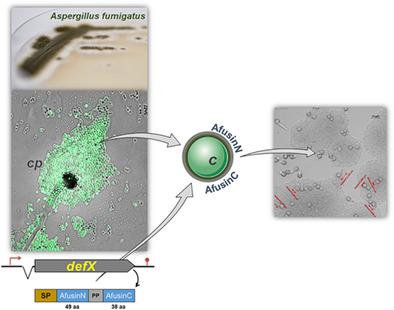当前位置:
X-MOL 学术
›
Cell. Microbiol.
›
论文详情
Our official English website, www.x-mol.net, welcomes your feedback! (Note: you will need to create a separate account there.)
The infectious propagules of Aspergillus fumigatus are coated with antimicrobial peptides
Cellular Microbiology ( IF 3.4 ) Pub Date : 2020-12-17 , DOI: 10.1111/cmi.13301 Michaela Dümig 1 , Jasmin Binder 1 , Anastasia Gaculenko 1 , Franziska Daul 1 , Lex Winandy 2 , Mike Hasenberg 3, 4 , Matthias Gunzer 4 , Reinhard Fischer 2 , Markus Künzler 5 , Sven Krappmann 1, 6
Cellular Microbiology ( IF 3.4 ) Pub Date : 2020-12-17 , DOI: 10.1111/cmi.13301 Michaela Dümig 1 , Jasmin Binder 1 , Anastasia Gaculenko 1 , Franziska Daul 1 , Lex Winandy 2 , Mike Hasenberg 3, 4 , Matthias Gunzer 4 , Reinhard Fischer 2 , Markus Künzler 5 , Sven Krappmann 1, 6
Affiliation

|
Fungal spores are unique cells that mediate dispersal and survival in the environment. For pathogenic fungi encountering a susceptible host, these specialised structures may serve as infectious particles. The main causative agent of the opportunistic disease aspergillosis, Aspergillus fumigatus, produces asexual spores, the conidia, that become dissipated by air flows or water currents but also serve as propagules to infect a susceptible host. We demonstrate that the defX gene of this mould encodes putative antimicrobial peptides resembling cysteine‐stabilised (CS)αβ defensins that are expressed in a specific spatial and temporal manner in the course of asexual spore formation. Localisation studies on strains expressing a fluorescent proxy or tagged defX alleles expose that these antimicrobial peptides are secreted to coat the conidial surface. Deletion mutants reveal that the spore‐associated defX gene products delay the growth of Gram‐positive Staphylococcus aureus and demonstrate that the defX gene and presumably its encoded spore‐associated defensins confer a growth advantage to the fungal opponent over bacterial competitors. These findings have implications with respect to the ecological niche of A. fumigatus that serves as a ‘virulence school’ for this human pathogenic mould; further relevance is given for the infectious process resulting in aspergillosis, considering competition with the host microbiome or co‐infecting microorganisms to break colonisation resistance at host surfaces.
中文翻译:

烟曲霉的感染性繁殖体涂有抗菌肽
真菌孢子是在环境中介导传播和存活的独特细胞。对于遇到易感宿主的病原真菌,这些特殊结构可作为传染性颗粒。机会性疾病曲霉病的主要病原体烟曲霉产生无性孢子,即分生孢子,其被气流或水流消散,但也可作为繁殖体感染易感宿主。我们证明该霉菌的defX基因编码类似于半胱氨酸稳定 (CS)αβ 防御素的假定抗菌肽,这些肽在无性孢子形成过程中以特定的时空方式表达。表达荧光代理或标记defX 的菌株的定位研究等位基因暴露出这些抗菌肽被分泌到分生孢子表面。缺失突变体表明,孢子相关defX基因产物延迟了革兰氏阳性金黄色葡萄球菌的生长,并证明defX基因及其编码的孢子相关防御素赋予真菌对手优于细菌竞争者的生长优势。这些发现对A. fumigatus的生态位有影响作为这种人类致病霉菌的“毒力学校”;考虑到与宿主微生物组的竞争或共同感染微生物以破坏宿主表面的定植抗性,对导致曲霉病的感染过程给出了进一步的相关性。
更新日期:2021-02-11
中文翻译:

烟曲霉的感染性繁殖体涂有抗菌肽
真菌孢子是在环境中介导传播和存活的独特细胞。对于遇到易感宿主的病原真菌,这些特殊结构可作为传染性颗粒。机会性疾病曲霉病的主要病原体烟曲霉产生无性孢子,即分生孢子,其被气流或水流消散,但也可作为繁殖体感染易感宿主。我们证明该霉菌的defX基因编码类似于半胱氨酸稳定 (CS)αβ 防御素的假定抗菌肽,这些肽在无性孢子形成过程中以特定的时空方式表达。表达荧光代理或标记defX 的菌株的定位研究等位基因暴露出这些抗菌肽被分泌到分生孢子表面。缺失突变体表明,孢子相关defX基因产物延迟了革兰氏阳性金黄色葡萄球菌的生长,并证明defX基因及其编码的孢子相关防御素赋予真菌对手优于细菌竞争者的生长优势。这些发现对A. fumigatus的生态位有影响作为这种人类致病霉菌的“毒力学校”;考虑到与宿主微生物组的竞争或共同感染微生物以破坏宿主表面的定植抗性,对导致曲霉病的感染过程给出了进一步的相关性。



























 京公网安备 11010802027423号
京公网安备 11010802027423号